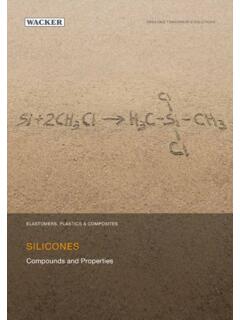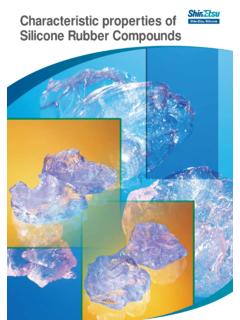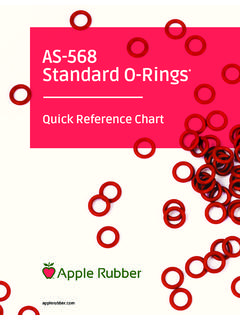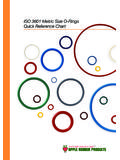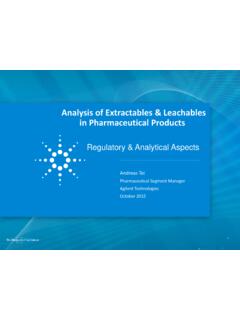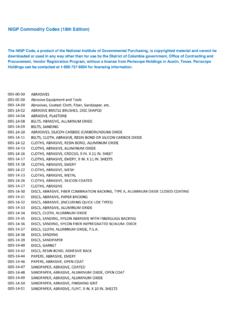Transcription of SOLID AND LIQUID SILICONE RUBBER - Wacker Chemie
1 CREATING TOMORROW S SOLUTIONSSOLID AND LIQUID SILICONE RUBBER MATERIAL AND PROCESSING GUIDELINES WELCOME TO THE WORLD OF SILICONE RUBBERELASTOSIL , LUMISIL , SILMIX and SILPURAN are registered trademarks of Wacker Chemie 1: SILICONE RUBBER Basic Principles 6 General characteristics of silicones and why Wacker silicones are so successful. Chemical fundamentals, the most important SILICONE RUBBER grades, their components and curing mechanisms Section 2: SILICONE RUBBER Material and Processing Advantages 14 Why and when SILICONE RUBBER is the material of choice. Material and processing advantages Section 3: Wacker SILICONE RUBBER Grades 20 Which applications and properties are typical? Overview of the most important applications and propertiesSection 4: Material Preparation 26 Temperature, viscosity, additives and what to consider in advance.
2 Storing and compounding SILICONE rubberSection 5: Processing of Material 38 How to process SILICONE RUBBER and where to be careful. Extrusion, compression molding, injection molding and coating of textilesSection 6: Secondary Finishing 62 How to finish cured SILICONE RUBBER . Post-curing, bonding technology, coating and printingSection 7: Service 74 How we support you along the entire process on product choice, technical support, customized ready-to-use compounds, Wacker ACADEMY, e-businessSection 8: RUBBER Solutions A-Z 82 Facts and figures about is one of the world's three biggest SILICONE manufacturers. For over 50 years, we have been developing, refining and producing silicones for a huge variety of applications. Global Production Local Customer SupportThe silicones that Wacker makes at its various production sites world-wide meet identical quality standards.
3 What's more, we have set up technical centers across the globe to offer all manner of support for product selec-tion, manufacturing, and end-product Production Sites for SILICONE RubberBurghausen (Germany): Production and technical centerN nchritz (Germany): ProductionPilsen (Czech Republic): ProductionAdrian (USA): Production and technical centerAnn Arbor (USA): R&D center Chino (USA): Production North Canton (USA): ProductionZhangjiagang (China): Production and technical center Akeno-Tsukuba (Japan): Production and technical centerJandira (Brazil): Technical centerMumbai (India): Technical centerAmtala (India): ProductionPanagarh (India): ProductionClose on 100 Years of Experience Close on 100 Years of InnovationWACKER is one of the most research-intensive companies in the industry. We maintain our own basic-research institute as well as industry-oriented innovation teams in close contact with universities.
4 This enables us to offer you ever more refined solutions. SILICONE RUBBER 1,000 and More GradesSilicones can be tailored to practically any application. Accordingly, we have a very wide and deep product range. Your choice of product depends on processing parameters and the prop-erties required for the cured RUBBER product. Our experts will gladly assist you in choosing the right SILICONE grade. 5 SECTION 1: SILICONE RUBBER BASIC PRINCIPLES6 ContentsGeneral characteristics of silicones and why Wacker silicones are so Chemical Structure 8 Why SILICONE RUBBER is inherently different from other Major Classes of SILICONE RUBBER 9 How SOLID and LIQUID SILICONE RUBBER grades differ, and what characterizes Components of SILICONE RUBBER 10 Fillers, additives and catalysts, and their role in formulation Curing 12 Peroxide curing and platinum-catalyzed addition curing: Two different processes and their specific advantages7 SiOOCH3 SiOCH3CH3 SiOCH3CH3 SiSiOCH3 CCH2CH3 Chemical StructureUncured SILICONE RUBBER contains polymers of different chain lengths.
5 It always comprises a principal silicon-oxygen chain (the siloxane backbone) and an organic moiety bound to the silicon. A silicon atom has four valence electrons, which is why SILICONE RUBBER is often abbreviated with a Q for quaternary group . The properties of SILICONE RUBBER vary greatly depending on the organic groups and the chemi-cal organic groups may be methyl, vi-nyl, phenyl or other groups. Depending on which organic groups are present, SILICONE polymers in common use are classified as follows: CHEMICAL STRUCTURES ilicones are made from quartz sand, a raw material available in practically unlim-ited quantities. Wacker manufactures SILICONE monomers in a closed-loop integrated production system based on the M ller-Rochow process, creating the precursors for around 3,000 SILICONE highly integrated energy and raw- material production system is exclusive to Wacker .
6 The by-products of the chemical processes are either used im-mediately or returned elsewhere to the production loop, so that virtually no waste is generated. Waste heat is also recov-ered and utilized, increasing the system's overall energy efficiency. From Sand to SiliconeSustainable ProductionMQ MQ, or polydimethylsiloxane (PDMS), denotes a polymer in which two methyl groups are bound to the silox-ane backbone. VMQVMQ stands for a polydimethylsiloxane in which a small number of methyl groups have been replaced by vinyl groups. PVMQPVMQ stands for an VMQ in which a small number of methyl groups have been replaced by phenyl groups. FVMQFVMQ stands for an VMQ in which a small number of methyl groups have been replaced by trifluoropropyl unitVinylmethylsiloxane MAJOR CLASSESA side from polymer structure, the viscosity frequently serves as a classification feature.
7 A distinction is accordingly made between LIQUID and SOLID SILICONE RUBBER . SOLID SILICONE RUBBER bar (standard supply form)Drum pair of LIQUID SILICONE RUBBER (A and B component) SOLID SILICONE RubberSolid SILICONE RUBBER contains polymers with a high molecular weight and rela-tively long polymer chains. It is referred to as HCR (= high consistency RUBBER ). Wacker offers two product ranges based on SOLID SILICONE RUBBER : a range of peroxide-curing grades marketed as ELASTOSIL R (R = RUBBER ) and a range of addition-curing (platinum-catalyzed) grades marketed as ELASTOSIL R plus. The standard delivery form is as bars measuring 90 x 100 mm (cross-section), which are wrapped in PE film and shipped in cartons. For special require-ments, we also offer our ready-to-use blends in the form of strips, round-cords, pellets and profile SILICONE RubberLiquid SILICONE RUBBER contains polymers of lower molecular weight and hence shorter chains.
8 It also has better flow properties. LIQUID SILICONE RUBBER is always addition-curing (platinum-cat-alyzed), and is marketed by Wacker as ELASTOSIL LR (where LR stands for LIQUID RUBBER ). LSR grades are sup-plied as 2-component systems. The A component contains the platinum cat-alyst, while the B component contains the crosslinker. 20-kg pails with a PE inliner ( inside 280 mm) 200-kg drums with a PE inliner ( inside mm)9 Aside from the pure polymer , uncured SILICONE RUBBER generally contains only three additional substances: crosslinker, fillers and additives. COMPONENTSU ncured, Filled Polymer Compared with Cured RubberUncured polymer with fillerPolymer with chemical crosslinks (red) forms a filled, elastic networkCuringCrosslinkers A crosslinker is required to convert the raw RUBBER into a mechanically stable cured product. Use is made of perox-ides or platinum catalyst systems (see section , pages 12-13, and , pages 36-37).
9 Fillers Fillers are needed to reinforce the elastic SILICONE network. The nature, composition and quantity of the fillers have a crucial influence on the proper-ties of the raw and cured RUBBER . Reinforcing fillers: Pyrogenic silica with very high BET surface areas (more than 100 m2/g) is the most frequently used reinforc-ing filler. Wacker HDK has proven to be especially effective here, although precipitated silica and carbon black can also be used. Non-reinforcing fillers: These have a fill-up function and are used to adjust certain properties. Quartz, for example, increases the cured RUBBER s resistance to various Compared with other elastomers, SILICONE RUBBER requires few additives because the essential properties are determined by the siloxane polymer used. Thus, a finished polymer com-pound may consist only of polymer and filler. Particularly notable is the fact that SILICONE RUBBER is free of curing accelerators or retarders, organic plasticizers and organic antioxidants.
10 Additives include stabilizers, masticat-ing aids and colorants. Stabilizers Stabilizers are available for special applications in order to optimize properties such as heat and media SILICONE RUBBER is generally transparent and can be colored as desired: from transparent through translucent to opaque. Wacker will supply you with suitable color pastes, both for LIQUID SILICONE RUBBER and SOLID SILICONE RUBBER . These color pastes are tailored specifically to the RUBBER grade in question and are easily blended into the compound while on the roll mill or via metering equipment during injection molding. It should be remembered that some additives are themselves inher-ently colored. You will find additional information on fillers, additives, stabilizers and colo-rants in section , as from page COLOR PASTES blend especially easily and fast into RUBBER compounds on the roll mill11 Peroxide CuringTo become an elastomeric material, raw SILICONE RUBBER has always to be cured.




